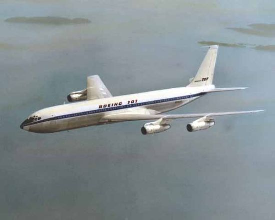Airplane impact tests conducted by WTC structural engineers in 1964, during the design of the Twin Towers, calculated that the towers would handle the impact of a Boeing 707 traveling at 600 mph without collapsing. Technical comparisons show that the 707 has more destructive force at cruising speed than the 767, the aircraft said to be used in the 9/11 attacks.
LEAD ENGINEER SKILLING: “THERE WOULD BE A HORRENDOUS FIRE. [BUT] THE BUILDING STRUCTURE WOULD STILL BE THERE.”
By AE911Truth Staff
 Early design tests confirmed that the Twin Towers could survive the impact of a Boeing 707, which is similar in size to the Boeing 767s (or reinforced military jets painted to look like commercial airplanes) that crashed into them on 9/11.
Early design tests confirmed that the Twin Towers could survive the impact of a Boeing 707, which is similar in size to the Boeing 767s (or reinforced military jets painted to look like commercial airplanes) that crashed into them on 9/11.
Both technical calculations and testimony from World Trade Center structural engineers confirm that the Twin Towers were built to withstand the impact from the passenger jets that hit them on 9/11.
Airplane impact tests conducted by WTC structural engineers during the design of the Twin Towers used the Boeing 707, which was one of the largest passenger jets in the world at the time. The results of the test, carried out early in 1964, calculated that the towers would handle the impact of a 707 traveling at 600 mph without collapsing.
Even though the two Boeing 767 aircraft that were said to be used in the 9/11 attacks were slightly larger than the 707, technical comparisons show that the 707 has more destructive force at cruising speed. The following analysis was compiled by 911research.net:
The maximum takeoff weight for a Boeing 707-320B is 336,000 pounds.
The maximum takeoff weight for a Boeing 767-200ER is 395,000 pounds.
The wingspan of a Boeing 707 is 146 feet.
The wingspan of a Boeing 767 is 156 feet.
The length of a Boeing 707 is 153 feet.
The length of a Boeing 767 is 159 feet.
The Boeing 707 could carry 23,000 gallons of fuel.
The Boeing 767 could carry 23,980 gallons of fuel.
The cruise speed of a Boeing 707 is 607 mph = 890 ft/s.
The cruise speed of a Boeing 767 is 530 mph = 777 ft/s.
So, the Boeing 707 and 767 are very similar aircraft, with the main differences being that the 767 is slightly heavier and the 707 is faster.
In designing the towers to withstand the impact of a Boeing 707, the designers would have assumed that the aircraft was operated normally. So they would have assumed that the aircraft was traveling at its cruise speed (i.e., not at faster speeds perhaps flown by suicide pilots). With this in mind, we can calculate the energy that the plane would impart to the towers in any accidental collision.
The kinetic energy released by the impact of a Boeing 707 at cruise speed is
= 0.5 x 336,000 x (890)^2/32.174
= 4.136 billion ft lbs force (5,607,720 Kilojoules).
The kinetic energy released by the impact of a Boeing 767 at cruise speed is
= 0.5 x 395,000 x (777)^2/32.174
= 3.706 billion ft lbs force (5,024,650 Kilojoules).
From this, we see that under normal flying conditions, a Boeing 707 would smash into the WTC with about 10 percent more energy than would the slightly heavier Boeing 767. That is, under normal flying conditions, a Boeing 707 would do more damage than a Boeing 767.
So what can be said about the actual impacts?
The speed of impact of AA Flight 11 was 470 mph = 689 ft/s.
The speed of impact of UA Flight 175 was 590 mph = 865 ft/s.
The kinetic energy released by the impact of AA Flight 11 was
= 0.5 x 395,000 x (689)^2/32.174
= 2.914 billion ft lbs force (3,950,950 Kilojoules).
This is well within limits that the towers were built to survive. So why did the North tower fall?
The kinetic energy released by the impact of UA Flight 175 was
= 0.5 x 395,000 x (865)^2/32.174
= 4.593 billion ft lbs force (6,227,270 Kilojoules).
This is within 10 percent of the energy released by the impact of a Boeing 707 at cruise speed. So, it would be also a surprise for the 767 impact to have caused the South tower to fall.
When interviewed in 1993, Lead WTC Structural Engineer John Skilling told The Seattle Times:
 Lead WTC Structural Engineer John Skilling was rightfully confident that neither the impact of a large passenger jet nor the ensuing office fires was capable of bringing down the Twin Towers.
Lead WTC Structural Engineer John Skilling was rightfully confident that neither the impact of a large passenger jet nor the ensuing office fires was capable of bringing down the Twin Towers.
“We looked at every possible thing we could think of that could happen to the buildings, even to the extent of an airplane hitting the side. . . . Our analysis indicated the biggest problem would be the fact that all the fuel (from the airplane) would dump into the building. There would be a horrendous fire. A lot of people would be killed. [But] the building structure would still be there.”
In 2001, Leslie Robertson, a WTC structural engineer who worked as a subordinate to Skilling, claimed that the Twin Towers were only able to withstand the impact of jet airplanes going no faster than 180 mph. However, not only are these statements contradicted by the design test results, they also contradict statements made by Robertson in 1984/1985, when he said that there was “little likelihood of a collapse no matter how the building was attacked.”
Robertson also claimed that the fires caused by a jet impact were not incorporated into the WTC design analysis. “To the best of our knowledge, little was known about the effects of a fire from such an aircraft, and no designs were prepared for that circumstance,” he stated in 2002. However, not only is this statement contradicted by Skilling, but it also lacks common sense, according to 9/11 researcher Kevin Ryan. “That’s kind of crazy. . . I don’t know how the planes would get to the buildings without jet fuel,” Ryan explains in a video presentation titled The NIST World Trade Center Report: A New Standard for Deception. “Who would design these buildings for jet plane impacts but not fuel fires?”
Not only were the towers designed to survive crashes of large jet aircraft, but they were designed to potentially survive multiple plane crashes. This assertion is supported by Frank A. Demartini, the on-site construction manager for the World Trade Center, who said on January 25, 2001:
“The building was designed to have a fully loaded 707 crash into it. That was the largest plane at the time. I believe that the building probably could sustain multiple impacts of jetliners because this structure is like the mosquito netting on your screen door—this intense grid—and the jet plane is just a pencil puncturing that screen netting. It really does nothing to the screen netting.”
Demartini appeared to be so confident that the towers would not collapse that he stayed behind, after the airplane impacts, to help save at least 50 people. As a result of his actions, he lost his life on 9/11.
Like the firefighters who perished in the WTC buildings, Demartini may very well have risked his life to save others, but the evidence suggests that he did not think he was endangering himself by simply going back into the building.
In addition, investigators from NIST who examined the destruction of the WTC skyscrapers told The New York Times in 2007 that newly disclosed documents from the 1960s show that the new York Port Authority, the original owners of Twin Towers, also considered aircraft moving at 600 mph, slightly faster and therefore more destructive than the ones that did hit the towers.
The information detailed in 9/11: Explosive Evidence — Experts Speak Out demonstrates clearly that pre-planted explosives — not jet plane impacts and fires — destroyed the Twin Towers. The WTC designers seemed to be correct in their analysis in the 1960s, and the evidence that these buildings were brought down by controlled demolition corroborates their conclusions.






